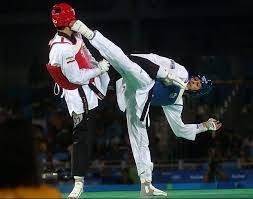About Taekwondo
Taekwondo is a Korean martial art that focuses on fast, powerful kicking techniques and dynamic movement. It was developed in the mid-20th century and has since become one of the most popular martial arts in the world, with millions of practitioners and official recognition as an Olympic sport.
The word “taekwondo” can be translated as “the way of the foot and fist,” reflecting its emphasis on striking techniques using the legs and hands. Taekwondo also includes throws, joint locks, and other grappling techniques, although these are less emphasized than in some other martial arts.
In taekwondo, practitioners wear a uniform called a dobok and progress through a series of colored belts and eventually black belt ranks as they develop their skills and knowledge of the art. Training includes both physical techniques and mental discipline, with an emphasis on self-defense, physical fitness, and personal growth.
Taekwondo competitions are held at various levels, from local tournaments to international championships. Matches are typically scored based on the number of points scored for kicks and punches, and penalties may be given for certain types of fouls.
Here’s some more information about taekwondo:
History:
Taekwondo was developed in the 1940s and 1950s in Korea, primarily by a group of martial arts practitioners who were seeking to create a standardized system that could be taught in schools and universities. The art draws on several earlier Korean martial arts, as well as influences from Chinese and Japanese martial arts.
In 1955, the Korea Taekwondo Association was established to oversee the development of the art, and over the next few decades, taekwondo spread around the world through international competitions and training programs. In 1988, it was officially recognized as an Olympic sport, further increasing its popularity and visibility.

Training:
Taekwondo training typically includes a combination of physical conditioning, technique practice, and mental discipline. Some common training techniques include:
Forms:
These are prearranged sequences of movements that simulate combat scenarios and help students develop their techniques, balance, and coordination.
Sparring:
This is a type of simulated combat where students wear protective gear and practice their techniques against a partner. Sparring can be either prearranged or free-form.
Breaking:
This is a technique where students break boards or other objects with their hands or feet, demonstrating their power and precision.
Self-defense:
Taekwondo also includes techniques for defending oneself against real-world attacks, such as grabs or strikes.
Benefits:
Practicing taekwondo can offer a range of physical, mental, and emotional benefits. Some of these include:
Improved physical fitness:
Taekwondo training can improve cardiovascular fitness, muscular strength and endurance, flexibility, and balance.
Self-defense skills:
Taekwondo teaches practical self-defense techniques that can help students feel more confident and capable in dangerous situations.
Mental discipline:
Taekwondo training requires focus, discipline, and perseverance, which can help students develop mental toughness and resilience.
Self-confidence:
As students progress through the ranks and develop their skills, they often experience a boost in self-confidence and self-esteem.
Here are some more details about taekwondo:
Belts:
In taekwondo, practitioners progress through a series of colored belts and eventually earn a black belt. The order of the belts varies slightly depending on the organization or school, but the most common ranking system is as follows:
White belt
Yellow belt
Green belt
Blue belt
Red belt
Black belt (1st dan)
After earning a black belt, students can continue to progress through higher dan ranks, which signify increasing levels of skill and mastery.
Competitions:
Taekwondo competitions are held at various levels, from local and regional events to international championships. Competitions typically involve sparring matches or forms competitions, where competitors perform prearranged sequences of movements.
In sparring matches, competitors wear protective gear and score points by landing kicks and punches on their opponent’s body. Matches may be divided by age, gender, weight class, or skill level.
Forms competitions, on the other hand, involve performing a series of techniques in a prescribed sequence. Judges evaluate competitors based on factors such as technique, power, balance, and presentation.
Philosophy:
Taekwondo is more than just a physical practice; it also includes a philosophical and ethical framework that emphasizes values such as respect, self-control, and perseverance. Some of the key tenets of taekwondo philosophy include:
